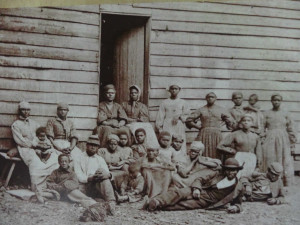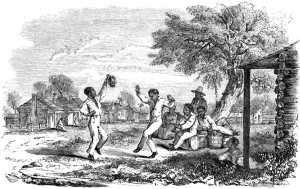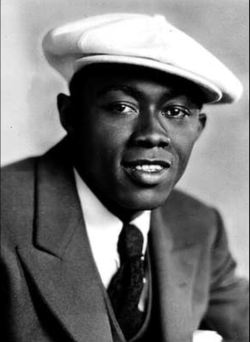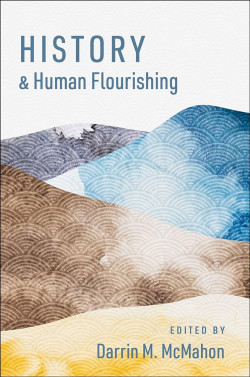A Short History of Black Happiness

African American history does not provide a great vantage point on the history of human flourishing. Instead, it is one of the most depressing subfields in American history—second perhaps only to Native American history.

A photograph from the slavery era, from Boone Hall Plantation in South Carolina.
© CC BY-ND 2.0 DEED
It tells the story of a people that suffered stark forms of oppression and subjugation in a society where many others flourished. It chronicles a long struggle to achieve full participation in American democracy that has been only been partially successful at best. In this era of #BlackLivesMatter and racism re-ascendant, can we draw meaningful connections between the study of African American history and positive psychology—or any form of study of the cultivation of well-being?
I’m not sure. On the one hand, I would freely admit the study of history has been essential to generations of African American activists, who have used it to recover their own past, inform their protest strategies, counter claims of Black inferiority rooted in racist readings of the past, and take joy in the rights and freedoms that Blacks have gained over time. But, on the other hand, the goals of such history have always fallen short of happiness, or human flourishing.
Instead, African Americans have turned to the past in search of pressing everyday wants and needs such as civil rights, social equality, economic opportunities, and physical security—or freedom from racial violence. Indeed, happiness is itself a problematic subject in African American history and culture because discussions of happiness or human flourishing among African Americans have often mobilized in support of white supremacy. While proponents of positive psychology tend to see human flourishing as a positive ideal, this brief overview of the history of Black happiness will suggest that discourses about human happiness and well-being can have many uses, not all of which are positive.
The first problem one faces in thinking about Black happiness is that African Americans look back on a long history of slavery, segregation, and other forms of racial discrimination that have made basic well-being difficult to achieve, and happiness still more problematic.
Moreover, throughout much of this history, African Americans have often been discussed in terms of racial stereotypes that characterize Blacks as an exceptionally happy and contented group. Such stereotypes first took shape during the slavery era, when slave traders and slaveholders defended their practice of human bondage by maintaining that the African race was naturally subservient and that Black people flourished in slavery. More common in the 19th century than earlier, these stereotypes likely first developed in religious critiques of slavery and the slave trade, which routinely described enslaved Black people as “unhappy.” Confronted with these critiques, the institution defenders maintained that enslaved people were very happy indeed.
Proslavery apologists maintained that slavery was a boon to the Blacks of the West Indies, after slavery there came under attack starting in the late 1700s. “The house of bondage” that enslaved Africans entered in the British West Indies was nothing short of a “land of freedom,” wrote slave trader and proslavery apologist Robert Norris in 1789. Among the British, they were “comfortable” and protected from cruelty, while in Africa the enslaved were subject to “most savage and wanton cruelty.”
His sentiments were amplified by other commentators such as George Pinckard, a British Army physician who visited the West Indies and Guiana in the first decade of the 19th century. A one-time visitor to the West Indies, Pinckard was not uniformly proslavery, but he was favorably impressed with slavery as practiced in Barbados and idealized the institution in terms that he seems to have borrowed from planters there. Barbados, he rejoiced, offered slavery “a happy home!” He acknowledged that not all the island’s planters were kind to their slaves but insisted that more of them were than not, and described the “negro yard” at a plantation called “Profit” as one of “the happiest communities within the wide circle of the globe.” “Fed, clothed and tenderly watched during sickness” by their “kind and affectionate” owner, the lucky residents of “Profit” had all their “wants supplied” and were “happy and contented.” Having never been free, they had no desire to be free and enjoyed their lives at least in part because they were spared the “tumult and vicissitudes of freedom.”
Used in both Britain and the United States, depiction of Blacks as happy slaves did little to discourage antislavery activists, who continued to maintain that slavery made Blacks miserable. But as challenges to slavery proliferated, proslavery uses of this stereotype became ever more emphatic. By the antebellum era, Black happiness was a constant theme in the American proslavery literature, whose writers even went so far as to maintain “the negro slaves of the South are the happiest . . . people in the world.” This view was likewise underscored in proslavery imagery, which often featured slaves dancing and playing musical instruments outside cozy cabins.

This image of happy slaves enjoying themselves is the frontispiece
in Aunt Phillis’s Cabin; or Southern Life As It Is (1852), an upbeat plantation
novel written to counter Harriet Beecher Stowe’s Uncle Tom’s Cabin (1852). Its author, Mary Eastman, rejected Stowe’s critique of slavery and instead sought to capture “the essential happiness of slaves in the South as compared to the
inevitable sufferings of free blacks and the working classes in the North.”
© Wikipedia Commons
These images of happy slaves were appealing even outside the South, as they allowed those who might otherwise question slavery to tell themselves that Blacks acquiesced to slavery because of the “genius of the African temperament,” because they are “instinctively . . . contented” and “quick to respond to the stimulus of joy, quick to forget (their) grief.”
Moreover, they also trained Northerners in what to see when they traveled south. Although educated at Oberlin College, a distinctly antislavery school, the young Benjamin Henry Whipple, an upstate New Yorker who traveled south for his health in the early 1840s, found the slaves he encountered there fully as contented as the slaveholders claimed they were. “They seem a happy race of beings and if you did not know it you would never imagine they were slaves,” he wrote in his diary. “The loud laugh, the clear dancing eye, the cheerful face show that in this sad world of sin and sorrow they know but very few.”
Popularized in traditions such as minstrelsy, a form of American musical theater in which whites Blacked up and gave performances as happy-go-lucky plantation darkies, notions of African Americans as an especially happy race grew if anything more entrenched after emancipation.
A 1901 book on Washington, D.C., to give just one of many possible examples, described the majority of the city’s Black population as “lazy, easy going work folk and loafers ‘out at the elbow, loose all over, and content whenever the sun shines on them.’” Naturally musical, as well as lighthearted, the “tatterdemalion happy-go-lucky Negro is always singing, when not laughing or whistling.”
These racial stereotypes make any discussion of African American happiness suspect as they underscore that Black happiness has often been invoked by whites to support slavery and other forms of white supremacy. In short, there is nothing straightforward about talking about happiness, and other positive emotions, when discussing the history of an oppressed group.
Black happiness as a masquerade
Indeed, even Black accounts of happiness make this point and, in doing so, suggest that the African American experience of happiness is often undercut by an awareness that expressions of Black joy could lend support to racist ideas about Black people.
Perhaps no one put this more plainly than John Lewis, a North Carolina slave who escaped to Canada sometime around 1850. In recounting his experience as a slave to abolitionist Benjamin Drew, Lewis recalled that he was deeply unhappy as a slave, and far more filled with thoughts of revenge than the slaveholders around him seem to recognize. Even when he might have seemed happy, his high spirits were undercut by sadness, as well as a strategic sense that a performance of happiness might appease white observers. As he explained to Drew:
They say slaves are happy, because they laugh, and are merry. I myself and three or four others, have received two hundred lashes in the day, and had our feet in fetters; yet, at night, we would sing and dance, and make others laugh at the rattling of our chains. Happy men we must have been! We did it to keep down trouble, and to keep our hearts from being completely broken: that is as true as the gospel! Just look at it,—must not we have been very happy? Yet I have done it myself—I have cut capers in chains.
Moreover, the practice of cutting capers in chains—dancing and skipping with apparent frivolity—did not end with slavery, but instead remained prevalent well into the 20th century, and arguably beyond. “We wear the mask that grins and lies,” Harlem Renaissance poet Paul Dunbar wrote, in a famous poem that essentially describes Black happiness as a ruse.
It hides our cheeks and shades our eyes,— This debt we pay to human guile;
With torn and bleeding hearts we smile, And mouth with myriad subtleties. . . .
Why should the world be over-wise, In counting all our tears and sighs? Nay, let them only see us, while
We wear the mask.
We smile, but, O great Christ, our cries To thee from tortured souls arise.
We sing, but oh the clay is vile Beneath our feet, and long the mile; But let the world dream otherwise, We wear the mask!
First published in 1896, Dunbar’s poem spoke to how even decades after slavery African Americans still felt the need to conceal their negative emotions behind an outward display of happiness—or what several critics have called a “minstrel grin.”
Far from just a matter of metaphor, performances of Black happiness were widely required in turn-of-the-century America. In the South, segregation did not just divide the races: It imposed a racial etiquette on Blacks that called for displays of good cheer and subservient smiles. Blacks who refused to comply were considered “uppity” and “could put themselves in grave danger.”

Born Lincoln Theodore Perry, Stepin Fetchit was a comedian and vaudeville performer who became Black America’s first movie star. Most
popular in the 1930s, he supplied comic relief in numerous Hollywood movies. He invariably played a servile, slow-witted, comically lazy, bumbling black man,
whose wide happy smile was part of his persona.
© IMDb
In 1908, for example, white night riders in Fulton County, Kentucky, even went so far as to lynch tobacco farmer David Walker for the crime of having a bad reputation as a “surly Negro.” Walker’s actual crime was likely something quite different; he was murdered at a time when his region’s white tobacco farmers were feuding with the American Tobacco company over crop prices, and sending out night riders to terrorize Black farmers who came down on the wrong side of the dispute. But Walker’s reputation as a man who did not cheerfully kowtow to whites may be one reason why he was singled out for especially deadly violence.
American race relations outside the South were somewhat less hierarchal and lethal than in the South, but even Northern and Western Blacks felt compelled to participate in happy displays of racial deference. The image of Black men and women as grinning, subservient Stepin Fetchits and beaming mammies was literally scripted for them by Hollywood films, which prior to the 1950s rarely featured Blacks in any other role.
Little wonder, then, that as the Black writer Alex Haley noted in 1964, even African Americans who lived in the North “simply and pragmatically adopted the grinning, feet-scuffing, head-scratching, ‘Yassuh-boss’ masquerade.” They did it because Southern and Northern whites alike responded favorably to this behavior, which left them “amused and psychologically disarmed,” therefore usually more likely to be cooperative “in granting or supplying the Negroes’ usually meager wants.”
Scholarly studies of Black happiness
I emphasize these Black masquerades of happiness because they have long compromised any study of Black well-being by making any simple claims about happiness suspect.
A case in point is the highly skeptical account of Black happiness that appears in the article “Is the Negro Happy?,” which appeared in the Journal of Abnormal and Social Psychology in 1929, and is, as far I can tell, the earliest scholarly study of Black happiness.
The article’s author was Albert S. Beckham. The third African American to receive a Ph.D. in psychology, Beckham, who earned his terminal degree at NYU, would eventually go on to become the first African American to hold the title of school psychologist. But at the time he took on the question “Is the Negro Happy?,” these credentials were still in the future. A “young Negro psychologist” with a master’s degree from Ohio State, Beckham began his career as an instructor at Howard University in 1924 and founded that institution’s first psychology lab before going on to pursue his Ph.D.
Beckham was a scholar of “the psychology of races from the normal and abnormal viewpoints” during the early years of his career, and his research in Black happiness was inspired by a query from a famous psychologist in one of America’s largest universities, who asked Beckham “what he termed a practical question—‘Is the Negro Happy!’” In doing so, this distinguished senior scholar also informed Beckham “that he had been told by northern and southern whites that they believed that the Negro is the happiest of the entire population.” Confronted with a stereotype-driven consensus that he seems to have found suspect at best, Beckham decided to dedicate his research to answering the scholar’s question.
Beckham, who was convinced that any answer to the “question of Negro happiness and contentment must come from the Negro himself,” set about addressing this question by conducting a four-year study in which he and his students collected opinions from “2,000 Negro college students, mostly freshmen and sophomores, from 500 unskilled laborers, 300 preachers, 210 physicians, 200 housewives (not employed in any outside occupation), 108 school teachers, 75 lawyers, and 50 musicians.” All completed a questionnaire in which they had to answer three questions:
Do you believe the Negro is happy! Answer Yes or No.
Are you happy as a Negro? Answer Yes or No.
Should the Negro be happy? Answer Yes or No.
Taken together, the answers of Beckham’s subjects were ambiguous at best. Opinions varied by both occupation and gender, but overall only 33.5% of Beckham’s subjects believed the Negro was happy, and a similarly small number (34.3%), answered yes to the question “Should the Negro be happy?” But for all that, although approximately two-thirds of Beckham’s subjects were convinced that Blacks were unhappy—and should be unhappy—a whopping 75.5% reported that they themselves were happy as Negroes.
Beckham was clearly confounded by his results. His subjects were happier than he thought they would be, and happier than their largely negative answers to his questions about whether Blacks as a group were, or should be, happy would seem to predict.
Moreover, the Black laborers he surveyed were generally happier than his Black professionals and student subjects, despite their social and economic disadvantages. Perhaps these disadvantages helped explain why.
“The Negro laborer is usually a happy man,” suggested Beckham, as he struggled to make sense of his data. However, he was not sure whether the happiness reported by members of this group was “real or imaginary,” and he even toyed with the idea that it might be simply a matter of ignorance: “The uneducated opines the happiness of the group because his own happiness consists in simple wants and meager pleasures.”
But in the end, Beckham concluded that the unlikely prevalence of individual happiness among his subjects, and especially in “the average Negro,” was confounding enough to be a matter of “social and abnormal psychology,” and ought to be defined as a complex. To the already long list of (psychological) complexes let us add another,” he suggested.
One more won’t hurt; it is the Negro complex. This is not necessarily synonymous with the inferiority complex although it might be at times. It is an emotional sublimation that enables the Negro to escape from dire reality. In this state he is able to simulate happiness. This has been his salvation. The Indian is lacking in this particular (sic). It is the existence of this complex that enabled the Negro to survive more than 200 years of slavery and a half century of economic and social pressure as a subject people.
Beckham’s suspicions about Black happiness seem to have been largely borne out by subsequent scholarship on Black life. Swedish sociologist Gunnar Myrdal, who completed an exhaustive study of American race relations under the sponsorship of the Carnegie Foundation in the late 1940s, also came to believe that his Black subjects tended to simulate positive emotions. As Myrdal wrote in his classic 1944 book, An American Dilemma: The Negro Problem and Modern Democracy:
Much of the humor that the Negro displays before the white man in the South is akin to that manufactured satisfaction with their miserable lot which the conquered people of Europe were forced to display before their German conquerors. The loud, high-pitched cackle that is commonly considered as the “Negro laugh” was evolved in slavery times as a means of appeasing the master by debasing oneself before him and making him think that one was contented. Some Negroes still “put it on” before whites in the South for a similar purpose.
These researchers’ suspicions about African American happiness are echoed in more recent scholarship on happiness, which has tended to show African Americans to be less happy than whites.
The news is not all bad. In a development widely attributed to the improvements in the “objective circumstances in the lives of Blacks” that have taken place as a result of the civil rights movement, the gap in the self-reported happiness of Blacks and whites has narrowed over the last 50 years. Whereas “in the 1970s, nearly a quarter of all Blacks reported being in the lowest category (‘not too happy’) compared to a tenth of whites, by the 2000s only a fifth of Blacks put themselves in this category, as compared to a tenth of whites,” write Betsey Stevenson and Justine Wolfers in a 2013 paper.
And in 2010, positive life evaluations among Black Americans reached an all-time high. In the Gallup National Well-Being Index (which describes Americans as “thriving,” “striving,” or “suffering,” according to how they rate their current and future lives on a ladder scale with steps numbered from one to ten) for that year 57.9% of Blacks described themselves as “thriving,” as compared to only 52.4% of whites. Similarly, Gallup Healthways data from 2008 to 2013 reported higher levels of optimism among Blacks than whites at this time.
Those findings were a conundrum to researchers who noted that improved sense of well-being in Blacks recorded during these years was not bolstered by comparable improvements in the Black-white earning gap and the education gap. “These findings do not accord easily with the status and situation of Black Americans, or the picture that comes from the recent riots in Baltimore and Ferguson,” Carol Graham of the Brookings Institute noted in 2015. They might well be an “Obama effect” rather an expression of enduring new optimism among Blacks, she suggested. History has borne this prediction out.

This essay is adapted from Mia Bay, “Toward a History of Black Happiness,” originally published In History and Human Flourishing, edited by Darrin M. McMahon (Oxford University Press, 2023).
Since the election of Donald Trump in 2016, Black life rating scores have plummeted. The percentage of Black people who reported themselves to be thriving in 2020 was 48.1%, which constitutes a nearly 10-percentage-point drop from its all-time high of the 57.9% who made this claim in 2010, and six-point drop from 53.1% who described themselves as “thriving” in 2016.
Likewise, self-reported personal happiness among Blacks and other people of color has also fallen dramatically. In a 2020 Gallup poll, only 77% of nonwhites reported being “very” or “fairly” happy versus more than 90% of whites—a drop of 11 percentage points from the Obama era.
As journalist Christopher Ingraham writes, “record nonwhite discontent in the era of a president who weaponizes racial discontent may not come as particular surprise.” As is well known, the Trump era has been marked by a “surge in hate crimes,” as well as a COVID-19 pandemic that has both dramatized and amplified American racial and economic disparities. An economic crisis, as well as a health crisis, the pandemic was particularly devastating among Blacks (and other people of color) whose “lower levels of income and wealth, higher unemployment, and greater levels of food and housing insecurity” left them “fewer buffers to absorb economic shocks.”
The history of Black happiness underscores that inequality is not just a social problem; it is also a psychological one. Higher levels of wealth and income shield more affluent Americans from many of the struggles, stresses, and insecurities experienced by lower-income Americans.
Moreover, these disparities extend across the color line in ways that suggest the eradication of economic exploitation and oppression is crucial to the psychological health of Americans as a group. For happiness is not just precarious among Blacks; it is declining among lower-income Americans in ways that indicate that the well-being of a large number of Americans is likely to decrease if economic inequality in the United States continues to grow ever more dramatic while the welfare state continues to erode. Even before the pandemic, lower-income Americans reported lower life satisfaction, greater “pain, worry, and anger,” and more “chronic pain and mental distress” than those with higher levels of income, according to a 2017 study by happiness researcher Carol Graham.
Many of these negative emotions, Graham notes, are closely associated with “the objective markers of being poor: dangerous neighborhood, poor quality schools and hospitals, lack of health insurance, unstable employment and working hours, and high rates of single parent households and unplanned pregnancy.” But they are also linked to “social determinants of health” such as the “difficulties of being poor in a country where the very visible lifestyles of the wealthy are increasingly out of reach.”
The history of Black happiness—that is, of an exploited class forced to hide its emotions in order to survive relentlessly hostile work and living environments—illuminates these difficulties. Moreover, it could well be the past as prologue for Americans in general, and especially those in the service professions, which are among the fastest-growing professions in the nation today. As sociologist Arlie Russell Hochschild first noted in her 1983 classic The Managed Heart, such workers are forced to perform cheeriness, thus creating an estrangement from their actual feelings in a way that constitutes an “occupational hazard” of their work.
The situation has only grown graver since then. Numerous companies from Trader Joe’s to Disney to Pret A Manger have begun requiring false cheer of their low-paid employees, while a 2017 summary of 95 medical studies reports that such workplace practices result in “trouble sleeping, headaches, and chest pain,” while also being linked to “aggression in the workplace.”
What then can history—African American history, in particular—tell us about the cultivation of well-being? It gives us the most important insight that few works positive psychology engage: It suggests that, all performances aside, human flourishing never truly exists within a context of exploitation and oppression.









